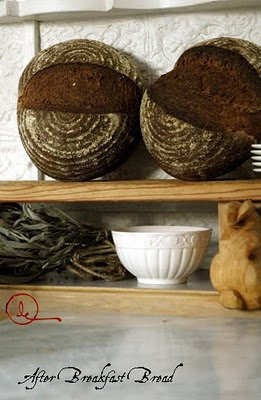After-Breakfast Bread by Nancy Young
By Nancy Young
 Most days for more than 30 years, I've baked everyday loaves for our family. I've studied bread, read bread, proofed, poolished [sic], pounded, punched down, and produced bread of every shape and description I could dream of. Perfect bread is like a perfect garden--ever elusive. The last loaves may have been better--the next loaves may be ideal; and the present loaves are almost gone already (despite any flaws.)
Most days for more than 30 years, I've baked everyday loaves for our family. I've studied bread, read bread, proofed, poolished [sic], pounded, punched down, and produced bread of every shape and description I could dream of. Perfect bread is like a perfect garden--ever elusive. The last loaves may have been better--the next loaves may be ideal; and the present loaves are almost gone already (despite any flaws.)
I'll try to document what I've learned here--not because of some exquisite expertise--but because I've never come across another bread-baking addict without learning something from them, and perhaps some of my own discoveries may be new to someone else.
One of the earliest lessons I learned is that bread, like a faithful pet, is wonderfully forgiving, and can do a lot of healing on its own. A rise or two can make a too-wet dough malleable or can moisturize a somewhat too-dry dough.
Bread also recycles a whole lot of leftovers that might otherwise go to waste--much in the same way a good soup or casserole can, only the addition is generally imperceptible. (An orange-scented cinnamon roll may not be suspected of being the final resting place of yesterday's cream of wheat.)
I frequently make bread while I clear away breakfast--bits of ingredients are just sitting there begging to be bread instead of back-of-the-frig casualties. All sorts of combinations are possible--bran flakes into honey-lemon bread, farina into Swedish limpa bread, grits into cornmeal braids, room temperature milk into Viennese raisin rolls, and apres-toast butter into whole wheat brioche. This "After Breakfast Bread," however, is the quickest and easiest; and while any cooked cereal can be used in the recipe, the most common victim at our house is oatmeal. This is a wholegrain bread--pretty much effortless--and a great first try bread for any waste-not-want-not personalities. (Of which I'm assuredly one.)
After-Breakfast Bread by Nancy Young
2 cups water, milk,or mixture of both (i.e. whatever's around) heated to 105 - 115 degrees
1 tablespoon dried yeast
1/2 cup any kind of sugar (optional)
1 tablespoon molasses or honey (optional)
1/4 cup butter or oil, or some of each
1/4 to 1/3 cup leftover cooked-oatmeal
1 tablespoon powdered cocoa (optional)
1 tablespoon salt
4 to 5 cups whole wheat flour
Dissolve yeast in liquid in the bowl of a heavy duty mixer. Add sugar and molasses or honey and allow to proof for approximately 5 minutes. Add butter or oil, oatmeal, cocoa, salt, and 4 cups of the whole wheat flour. Using the paddle attachment of the mixer, beat ingredients thoroughly. Stop mixer and check the consistency of the dough. Unless the dough is very thin, let dough sit for 15 minutes. (Whole wheat doughs thicken as they sit.) If dough seems too slack, however, add another cup or more of flour. Continue beating another five minutes. Dough should eventually clean sides of bowl. Remove paddle and allow dough to rise in the mixing bowl until doubled. This takes about an hour. Deflate dough and shape into two rounds using two 1 1/2-pound bannetons, as pictured above, or in any free-form round. Allow to rise until doubled, approximately 30 to 45 minutes (preheat oven during this time to 375 degrees). Bake until loaves test clean when pierced with a skewer, about 35 minutes. Allow to cool on racks before slicing.
The custom-made rack shown above is indispensable in our kitchen, as it allows us to pull loaves directly from the oven and both cool and display them until they're devoured. Instructions for creating such a cooling rack are featured in Vol. 8 No. 1 of The Storybook Home Journal: A Quillcote Christmas.
Tags: 2010, Recipes by Nancy Young
Browse articles by year: 2025 . 2024 . 2023 . 2022 . 2021 . 2020 . 2019 . 2018 . 2017 . 2016 . 2015 . 2014 . 2013 . 2012 . 2011 . 2010 . 2009 . 2008 . 2007 . 2006 . 2005 . 2004 . 2003 . 2002 . 2001 . 2000 . 1999 . 1998 . 1997 . 1996
Browse articles by topic: Art lessons . BenHaven Archives . Blank art diaries . Fine art photography . Framing . Illustration . Inspiration and creativity . Isles of Rune . Limited Editions Collection . My Fathers Captivity . News . Novellas . Oil paintings and prints . Operations announcements . Orders and shipping . Overview . Portfolios . The Papers of Seymore Wainscott . Project commentaries . Recipes by Nancy Young . Recommended reading . Recommended viewing . Temple artworks . The Storybook Home Journal . Tips and techniques . Tools supplies and operations
Browse articles by topic: Art lessons . BenHaven Archives . Blank art diaries . Fine art photography . Framing . Illustration . Inspiration and creativity . Isles of Rune . Limited Editions Collection . My Fathers Captivity . News . Novellas . Oil paintings and prints . Operations announcements . Orders and shipping . Overview . Portfolios . The Papers of Seymore Wainscott . Project commentaries . Recipes by Nancy Young . Recommended reading . Recommended viewing . Temple artworks . The Storybook Home Journal . Tips and techniques . Tools supplies and operations